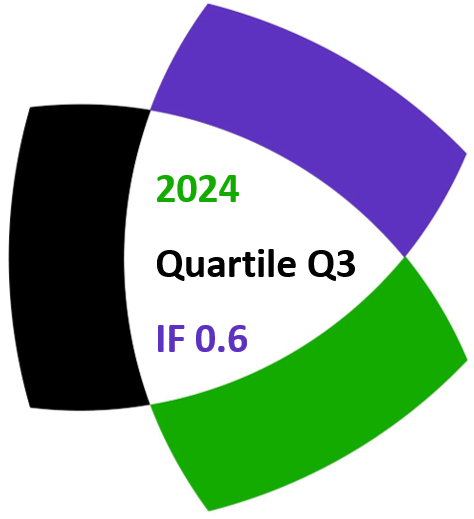K. Anitha, I. Mumtaj Fathima and A. R. Vijayalakshmi
Notes on Number Theory and Discrete Mathematics
Print ISSN 1310–5132, Online ISSN 2367–8275
Volume 30, 2024, Number 2, Pages 223–235
DOI: 10.7546/nntdm.2024.30.2.223-235
Full paper (PDF, 259 Kb)
Details
Authors and affiliations
K. Anitha ![]()
![]()
Department of Mathematics, SRM IST Ramapuram
Chennai 600089, India
I. Mumtaj Fathima ![]()
![]()
Research Scholar, Department of Mathematics,
Sri Venkateswara College of Engineering (Affiliated to Anna University)
Sriperumbudur, Chennai 602117, India
A. R. Vijayalakshmi ![]()
![]()
Department of Mathematics, Sri Venkateswara College of Engineering
Sriperumbudur, Chennai 602117, India
Abstract
We consider the negative polynomial Pell’s equation ![]() , where
, where ![]() be some fixed, monic, square-free, even degree polynomials. In this paper, we investigate the existence of polynomial solutions
be some fixed, monic, square-free, even degree polynomials. In this paper, we investigate the existence of polynomial solutions ![]() with integer coefficients.
with integer coefficients.
Keywords
- Pell’s equation
- Polynomial Pell’s equation
- Gaussian integers
- ABC conjecture for polynomials
2020 Mathematics Subject Classification
- 11A99
- 11C08
- 11D99
References
- Beardon, A. F., & Short, I. (2010). The Seidel, Stern, Stolz and Van Vleck Theorem on continued fractions. Bulletin of the the London Mathematical Society, 42(3), 457–466.
- Bunder, M., & Tonien, J. (2017). Closed form expressions for two harmonic continued fractions. The Mathematical Gazette, 101(552), 439–448.
- Comte, L. (1974). Advanced Combinatorics: The Art of Finite and Infinite Expansions (Revised and enlarged edition). Dordrecht: D. Reidel Publishing Co, Boston.
- Dubickas, A., & Steuding, J. (2004). The polynomial Pell equation. Elemente der
Mathematik, 59(4), 133–143. - Fouvry, É., & Klüners, J. (2010). On the negative Pell equation. Annals of Mathematics, 172(3), 2035–2104.
- Hua, L. K. (1982). Introduction to Number Theory. Springer, Berlin.
- Kim, D. S., & Kim, T. (2020). A note on a new type of generate Bernoulli numbers. Russian Journal of Mathematical Physics, 27(2), 227–235.
- Kim, T., & Kim, D. S. (2020). Degenerate polyexponential functions and degenerate Bell polynomials. Journal of Mathematical Analysis and Applications, 487(2), Article 124017.
- Kim, D. S., Kim, T., Kwon, J., & Lee, H. (2020). A note on λ-Bernoulli numbers of the second kind. Advanced Studies in Contemporary Mathematics, 30(2), 187–195.
- Kim, T., & Kim, D. S. (2020). Some relations of two type 2 polynomials and discrete harmonic numbers and polynomials. Symmetry, 12(6), 905.
- Kim, T., & Kim, D. S. (2023). Combinatorial identities involving degenerate harmonic and hyperharmonic numbers. Advances in Applied Mathematics, 148, Article 102535.
- Kim, T., & Kim, D. S. (2023). Some identities involving degenerate Stirling numbers associated with several degenerate polynomials and numbers. Russian Journal of Mathematical Physics, 30(1), 62–75.
- Kim, T., & Kim, D. S. (2023). Some identities on degenerate hyperharmonic numbers. Georgian Mathematical Journal, 30(2), 255–262.
- Koymans, P., & Pagano, C. (2020). Higher Rédei reciprocity and integral points on conics. arXiv preprint: 2005.14157.
- Lagrange, J. L. (1767). Sur la solution des problèmes indeterminés du second degré. Vol. XXIII, Berlin.
- Lagrange, J. L. (1768). Histoire de l’ Académie de Berlin. Vol. XXIV, Berlin.
- Lang, S. (1993). Die abc-Vermutung. Elemente der Mathematik, 48, 89–99.
- Lorentzen, L., & Waadeland, H. (2008). Continued Fractions. Volume 1: Convergence Theory. Atlantis Press.
- Mason, R. C. (1984). Diophantine equations over function fields. LMS Lecture Notes, 96, Cambridge University Press.
- Nathanson, M. B. (1976). Polynomial Pell’s equation. Proceedings of the American Mathematical Society, 56, 89–92.
- Niven, I., Zuckerman, H. S., & Montgomery, H. L. (1991). An Introduction to the Theory of Numbers (5th ed.). University of Michigan, John Wiley & Sons, New York.
- Pastor, A. V. (2001). Generalized Chebyshev polynomials and the Pell–Abel equation. Fundamentalnaya i Prikladnaya Matematika, 7(4), 1123–1145.
- Seidel, L. (1846). Untersuchungen über die Konvergenz und Divergenz der Kettenbrüuche. Habilschrift, München.
- Silverman, J. H. (1984). The S-unit equation over function fields. Mathematical
Proceedings of the Cambridge Philosophical Society, 95(1), 3–4. - Snyder, N. (2000). An alternate proof of Mason’s theorem. Elemente der Mathematik, 55(3), 93–94.
- Stark, H. M. (1978). An Introduction to Number Theory. MIT Press, Cambridge (MA).
- Stern, M. A. (1848). Über die Kennzeichen der Konvergenz eins Kettenbruchs. Journal für die Reine und Angewandte Mathematik, 1848(37), 255–272.
- Stothers, W. W. (1981). Polynomial identities and Hauptmoduln. The Quarterly Journal of Mathematics, 32(3), 349–370.
Manuscript history
- Received: 29 October 2022
- Revised: 28 March 2024
- Accepted: 24 April 2024
- Online First: 7 May 2024
Copyright information
![]() Ⓒ 2024 by the Authors.
Ⓒ 2024 by the Authors.
This is an Open Access paper distributed under the terms and conditions of the Creative Commons Attribution 4.0 International License (CC BY 4.0).
Related papers
Cite this paper
Anitha, K., Mumtaj Fathima, I., & Vijayalakshmi, A. R. (2024). Some new results on the negative polynomial Pell’s equation. Notes on Number Theory and Discrete Mathematics, 30(2), 223-235, DOI: 10.7546/nntdm.2024.30.2.223-235.


